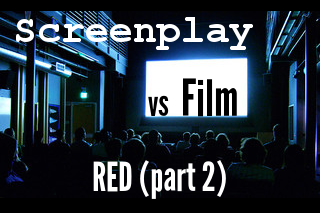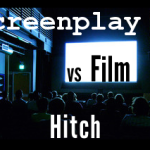Today’s screenwriting tips are a continuation of yesterday’s post Screenplay vs Film: 10 Screenwriting Tips from RED. Remember, every Tuesday, I’ll share what I learned by comparing the screenplay and film versions of popular movies, so this Screenplay vs Film series should produce a nice collection of practical screenwriting tips for your to review at your leisure. We’ll start with…
Screenwriting Tip #6: Handling injections of morality
You don’t ever want your screenplay to be preachy or read like an after-school special. At the same time, I think many screenwriters want their screenplays to mean something and not just be mindless entertainment. Conveying your observations of society in your screenplay is one way to do that.
RED provides a good example of how to incorporate a message without being too preachy. The screenwriters accomplished this by two short dialogues.
One is a speech by the ultra paranoid Marvin, played to perfection by John Malkovich:
Marvin paces, getting more and more worked up.
MARVIN
Dammit. DAMMIT!
(beat)
You know what’s WRONG with this government — with these Patriot Act wiretapping, preemptive war starting, extreme renditioning, fear-mongering War on Terror bastards?
FRANK
They’re trying to kill us?
MARVIN
Exactly!
A beat as Frank waits for more.
FRANK
It’s why we’re here, Marvin.
MARVIN
Well we’ve got to do something.
(beat)
Who else on this list is still alive?
The second dialogue is Frank’s:
FRANK
It’s not that I want revenge. I don’t care about you. But there are rules about how you treat your tools. The people who do things for you do it because they believe in the greater good.
Frank holds up his set of dog tags. Now we see that the name and number have been filed out.
FRANK (cont’d)
I joined up when I was seventeen and took an oath to defend this country. They stamped these tags with the name my mother gave me. Later the Company erased that name forever. These are a symbol of that sacrifice.
When you’re reading these dialogues in isolation, they may seem preachy to you, but within the context of the screenplay, they aren’t. They worked for several reasons. Marvin’s speech balances truth with humor, and comedy always removes a preachy sting from a speech. Frank’s dialogue works not because it’s funny, but because it’s not too long…and it came from character.
Throughout the screenplay, Frank has carried these dog tags with him. He even gave them to Sarah before he entered the Russian compound, just in case he didn’t come back. Clearly, they were important to him, and after everything that he’s been through–not just in the movie, but also in his former life as an active CIA agent–he’s certainly earned that moment to tell off the government that turned him into a killing machine.
If you’ve seen the movie, you might saying, “dog tags? what dog tags?”
You’re right–these speeches and those dog tags were eliminated from the movie. I’m not sure why. With the unending wars in the Middle East, it seemed like a particularly relevant message. Its removal is even more curious since one of the driving themes of the RED comic books was the toll killing takes on man’s psyche, even if it’s done for seemingly honorable reasons.
Why we may never know the rationale for removing this message, at least the original screenplay provides a solid example on how to incorporate social commentary into our stories.
Screenwriting Tip #7: This is a visual medium, folks!
In the RED movie, Frank sneaks into the CIA’s Langley headquarters with Sarah in order to determine who gave the executive order to get rid of him and his fellow operatives (and also to meet Cooper and give him a piece of his mind–or fist). Frank kicks Cooper’s butt pretty hard…and only stops when Cooper whips out a gun and shoots him. Now, how do you exit a secure building like the CIA filled with people like Cooper? It’s not like Frank can just walk out of there. He has to have an exit plan. A highly effective and clever exit plan.
In the screenplay, Frank pulled the fire alarm, busted open a fire control room, removed a gallon of halon gas, and started spraying it all around the CIA headquarters. So for those of you who didn’t exactly warm to the periodical chart of elements, apparently, halon bonds to oxygen, removing it from the atmosphere. A good thing if you’re trying to put out a fire, but a bad thing if you’re a CIA agent in the hallway and you’d like to, you know, breathe.
I forget why Frank isn’t affected by the halon, but while the CIA workers keel to the floor since they’re having trouble breathing, he manages to walk out of the CIA with Sarah and into a waiting car *spoiler alert* manned by Marvin–and Joe, who surprise (!) wasn’t dead after all.
In the movie, the halon plan was abandoned. Good thing too. While it’s certainly a good way to get Frank out of his predicament, halon is a colorless gas. It doesn’t carry much visual oompf. Obviously, we’ll see the CIA worker bees falling to the floor…but we won’t see the reason for it.
In the movie, Frank was still able to exit the CIA safely. He combined acetone and other ingredients, creating a fire, which of course would signal to the fire department to rush to Langley.
When the firemen enter the building, he knocks one out, steals his uniform, and walks out with the fireman tossed over his shoulder like he’s the heroic fireman helping a man in need of medical care. Then, he doesn’t just jump into a regular car, no sir. His sweet ride is none other than a fire truck (still manned by Marvin and Joe) which is…a nice, bright visual item that will look a lot better on the big screen than, let’s say, a beige sedan.
Screenwriting Tip #8: Use flashbacks wisely
In both the screenplay and film versions of RED, the CIA sent their agents to kill Frank and his team because several years ago, they had participated in a clean up of a massacre perpetuated by a US civilian…who happened to be the son of US Senator and who is now the vice president of the United States.
In the movie, the massacre took place in South America, but in the original screenplay, it took place in Afghanistan. And there were a number of flashbacks to the war-torn country in the script. For the movie version, they changed the location of the masscre to South America, and they eliminated the flashback scenes altogether.
I think it was a wise choice because those flashbacks really jolted me out of the screenplay when I was reading it. In fact, at some points, it made it harder to understand why the CIA was hellbent on killing their own. While the confusion was temporary, you don’t want your reader or audience to be confused. Ever.
The other reason it was a good idea to eliminate the flashbacks is because of costs. Setting up a sound stage to look like Afghanistan would’ve increased the budget–and for no good reason. When you’re writing your own script, I don’t think you should be terribly budget conscious unless your intent is to see your screenplay made as an indie film.
But one of these days, if you stick to screenwriting, you’ll be in the lucky position of having your screenplay made, and the producers will probably ask you to rewrite scenes to make them more cost-effective. Removing flashbacks is a simple way to do that without having to mess around with your core story structure. (For more tips on handling flashbacks, check out the “magic of mystery” section in Screenwriting Structure: Lessons from the Hangover.)
Screenwriting Tip #9: If you happen to snag an Oscar winner, keep him around in your screenplay
In the original RED screenplay, Dunning, the international weapons dealer was killed in his mansion by the CIA after Joe sacrificed himself to enable Frank and Marvin’s escape. But in the movie, Dunning wasn’t killed. In fact, he made a phoenix-like reappearance during the climax.
I suspect that the ending was rewritten once they snagged Richard Dreyfuss to play Dunning. If you are ever in the envious position of securing A-list talent in your screenplay for even your supporting cast–don’t get rid of them prematurely. Keep them in the game as long as possible.
It can be tricky to do this and maintain your screenplay’s coherence. This is what they did in RED: Dunning wasn’t killed by the CIA in his mansion, but was left there still tied up with duct tape. At the end of the movie, Frank has captured the vice president and brings him to Cooper. In the middle of this, Dunning dramatically pulls into the parking garage in a white limo with Sarah in tow. He shoots the vice president and demands that Frank trade his life for Sarah’s.
Now you might be thinking that this screenwriting tip is not going to be very helpful to you. First all, don’t be so pessimistic Eeyore! Great roles are actor bait, even if they’re supporting ones. You never know who your screenplay might attract. Secondly, you yourself might be in the position of revising your screenplay and are trying to get rid of some roles while expanding others, especially if some of your characters are too similar to each other or if they come across as redundant.
Examine the way RED approached this major change and hopefully, it will help you brainstorm ways to solve your problem. At the very least, when you’re in the screenwriting trenches, it is a comforting reminder that it can be done!
Screenwriting Tip #10: Switching your villain doesn’t always work
So as you know from screenwriting tip #9, the current vice president, named Stanton, went crazy and was responsible for this massive massacre in South America. In the movie, he was the one was using the CIA as his personal hit squad to remove all people who knew about the massacre because he feared they could interfere with his bid for the presidency. (Well, he claimed that Dunning ordered the killings, but I think he played a significant role in that decision.) He was a self-interested jerk from beginning till end, pretty much the walking definition of a politician.
But in the screenplay, things went down a little differently. In the screenplay, the veep DIDN’T order the killings, Frank mistakenly assumed he did. The veep wasn’t the real villain, the Director of Operations at the CIA was. HE ordered the killings so that he would “own” Stanton when Stanton became president. Now, doesn’t that feel like a big cop out to you? I know it did to me when I was reading the screenplay.
It seemed like the Hoeber brothers were reluctant to make the US vice president a through and through villain. And maybe a long time ago, it may have been difficult for the American public to accept the veep as a villain in a movie. (And a way before that, it would’ve been difficult for the rest of the world to accept the veep as a villain.) But time’s achanged, folks, and with the behavior of past presidents being what it has, I think the world can accept that leaders of any country can be criminals and will go to sickening lengths to maintain their power.
There’s also another screenwriting issue to analyze here, and that’s the surprise element. Maybe the Hoeber brothers thought it was cool to do a villain switch at the end because it is a plot twist that would surprise the audience. Plot twists are generally good, especially major ones at the end. I think it was one of the more original elements of the family comedy G-Force, where the villain wasn’t the home appliance billionaire played by Bill Nighy, but is one of the gerbil’s former colleagues and friend, the star-nosed mole voiced by Nic Cage.
Why did that villain switch work but the RED one didn’t? In G-Force, the villain was no longer a corporate suit but a friend of the spy gerbils who was now working against his own friends. In the RED screenplay, the villain switched from one greedy bureaucrat…to another greedy bureaucrat. It’s almost the same person, so making the switch doesn’t give the screenplay an extra jolt of surprise.
Notice I said almost. The veep is different to the CIA operations director in a significant way: he’s the second in command of the United States. As such, he has more power (at least in theory, with the CIA, who knows?) and so the villain switch actually downgrades the villain, making the new villain less powerful than the old. That kind of downgrading just doesn’t work in screenplay dynamics. Everything’s supposed to go bigger in a screenplay–especially at the climax.
So when you’re writing your own screenplay and you’re thinking about doing a villain twist to add a little spice to your kick-butt climax, make sure you choose your new villain carefully. He (or she) should have the ability to make the audience go “ooo” when they see the big reveal on screen.
Final thoughts
I want to iterate that I’m not trying to rip apart the Hoeber brother’s screenplay ’cause I think it’s seriously good. If your screenplay drafts are like theirs, you have a golden career in screenwriting. I’m examining these tiny differences and picking them apart to provide screenwriting tips that will hopefully make your journey into Hollywood that much smoother.
While today’s RED post focused on screenwriting techniques, tomorrow’s post will focus on screenplay structure and RED’s plot points. Something to study if you’re writing a hybrid screenplay like an action comedy!
Watching a blank screen by (with modifications) Kenneth Lu




















